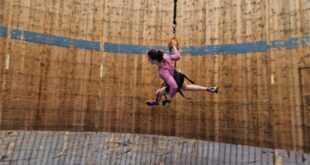A new documentary explores the weird and wonderful world of butts

Butts come in all shapes and sizes, but that's not the half of it.
In fact, the world of rear ends and anuses may surprise you. Butt Seriously, a documentary from The Nature of Things, explores this topic in eye-opening detail, including where butts came from, why we have them, and the incredible things they can do.
Humans have the biggest booties
Most animals have a rear end to expel waste, and those posteriors take on a lot of different forms. There are beetles with exploding backsides, marine worms that can grow hundreds of butts, and sponges and anemones, whose butts double as a mouth (fun!). But when it comes to the classic "bum," one animal stands above the rest.
Humans have fleshy butts, and that's because we stand up. We need the power of the gluteus muscles to stand erect, run and jump.
So remember to thank your butt: without it, you wouldn't be able to walk at all!
The transient anus: an on-demand rear end
As humans, we're at the mercy of our anuses (when nature calls). But for some invertebrates, they're the ones in charge.
Most of the time, the warty comb jelly — a cannibalistic, transparent blob native to the Atlantic coasts of North and South America — has no anus to speak of. (It isn't actually a jellyfish, but a ctenophore, an invertebrate that doesn't sting and uses fluttering cilia to move through the ocean.)
And when it needs to expel waste, it conjures an anus to do so. It's called a transient anus, and this jelly is the only known animal to have one.
When it needs to go, its gut fuses with its epidermis and creates an opening, which disappears after it's done defecating. Adults do it about once every hour. It's believed this anatomical quirk may be an intermediate form of the anus and hold clues about how ours evolved.
The wonderful world of inverte-butts
If you think you've seen bums of all shapes and sizes, think again.
The rear ends we know and love are only the tip of the iceberg in a vast and varied sea of backsides.
Many researchers look to invertebrates like worms, slugs and insects to better understand why and how anuses evolved, and they've discovered impressive (and scary) examples out there.
Dragonfly larvae engage their very own jet propulsion, using their butts to boost themselves through the water.
Beaded lacewing larvae can clear a room (literally) by paralyzing nearby termites with a seriously toxic fart and eating them.
Honeypot ants can store food in their backsides, then dispense that nectar from their swollen abdomens (by vomiting) to hungry members of the colony.
But possibly the most impressive are bombardier beetles. Many of these beetles are hiding a secret weapon up their butts: the ability to shoot a boiling mix of irritating chemicals out of their behinds to escape predators.
"That's an attack butt," said Ainsley Seago, the associate curator of invertebrate zoology at the Carnegie Museum of Natural History in Pittsburgh. "That is a chemical explosion."
A bombardier beetle stores two chemicals — hydrogen peroxide and hydroquinone — in separate sacs in its abdomen. When threatened, it quickly releases the chemicals, which mix and shoot out its butt at temperatures up to a scalding 100 C.
"There's a powerful exothermic reaction," Seago said. "It's an explosive blast — they can aim [it in] any direction 360 degrees around them … like a deadly butt sprinkler."
A butt you can breathe with
During the winter months, some turtles can hibernate underwater for months at a time.
As lakes and ponds freeze over, painted turtles hunker down under the ice and slow their metabolism to a crawl. But because they're air-breathing reptiles, that raises the problem of getting enough oxygen while they're submerged for months.
Butts to the rescue!
Hibernating turtles don't require much oxygen, but in a process called cloacal respiration, the blood vessels around their all-purpose opening absorb all the oxygen they need from the water around them.
This ability is seen in other animals, like some fish, and has inspired research into whether humans can do this too.
You read that right. Researchers are interested in finding new ways to make breathing easier for people under respiratory distress or who are looking for an edge. In studying mice and pigs, Dr. Takanori Takebe found they could survive in normally lethal low-oxygen conditions when a highly oxygenated liquid was injected into their intestines.
Human trials are next, and breathing through our butts is getting interest from athletes, astronauts and pilots, who could benefit from improving their oxygen uptake or being able to survive in low-oxygen conditions.
It may come with side-effects, of course, and work more as a targeted therapy. Breathing through our intestines, if safe, would only be short-lived and could cause complications for digestion as the oxygen would likely kill gut microbes.

Add some “good” to your morning and evening.
Get our curated selection of must-watch docs from CBC in your inbox every week!
The next issue of Documentaries newsletter will soon be in your inbox.
Discover all CBC newsletters in the Subscription Centre.
*****
Credit belongs to : www.cbc.ca
 MaharlikaNews | Canada Leading Online Filipino Newspaper Portal The No. 1 most engaged information website for Filipino – Canadian in Canada. MaharlikaNews.com received almost a quarter a million visitors in 2020.
MaharlikaNews | Canada Leading Online Filipino Newspaper Portal The No. 1 most engaged information website for Filipino – Canadian in Canada. MaharlikaNews.com received almost a quarter a million visitors in 2020.







